3 Days in Lisbon: How to Plan the Perfect Lisbon Itinerary
We loved Lisbon. It’s the largest city in Portugal – also the capital – with a rich history that features a diverse cast of characters, from the Romans and Visigoths in medieval times, to the Muslims hailing from North Africa, to the Christian Crusaders, and many more.
They were also the first people to go around the Cape of Good Hope, the southern tip of Africa to India (you can see Vasco da Gama’s tomb at the Jerónimos Monastery in Belém), and the fact that Portugal played such a big role in early exploration at sea is something I always forget.
Over the course of your 3 days in Lisbon, you’ll learn all about the rich history – some good, some not so good – that was made in Lisbon, one of the most storied cities in all of Europe.
As we were on a walking tour with Isabel, a local who now lives in a suburb of Lisbon, she was telling us about the earthquake in 1755 (and the fires and tsunami that soon followed) that leveled large swaths of Lisbon.
Most of the city had to be rebuilt from the ground up, which immediately reminded me of the forest fires in California, our home state, that have grown more and more intense with each passing year. In their wake, they leave destruction and suffering. But then a beautiful thing happens.
From the ashes, something new emerges. In the case of California’s forests, it’s a new set of flora and fauna. In Lisbon’s case, a modern city emerged, more resilient and equipped to deal with future disasters thanks, in part, to the urban planning of the Baixa District, which was envisioned and brought to life by the Prime Minister after the earthquake, Marquês de Pombal.
Today, Lisbon is firmly on the tourist map after a series of “best new destination” wins in travel magazines over the past decade or so.
The Portuguese capital is a real treat, full of incredible views from miradouros that look out over the colorful buildings adorning the city’s many hills, great food and drinks including fresh seafood that is among the best in the world, and some amazing historical sights and stories.
In this guide to planning your Lisbon itinerary, we’re going to go through everything you’ll need to organize an amazing trip to Lisbon.
From the boring logistics, like how to get around and where to stay, to a complete 3 day Lisbon itinerary, to itinerary alternatives if you have more or less time, we’ve done our best to give you all the information you need to plan your trip, all in one place.
Throughout the guide, we’ll share our favorite finds and experiences in Lisbon based on our trip to help you plan your unforgettable trip.
Sound good to you? Let’s get into it!
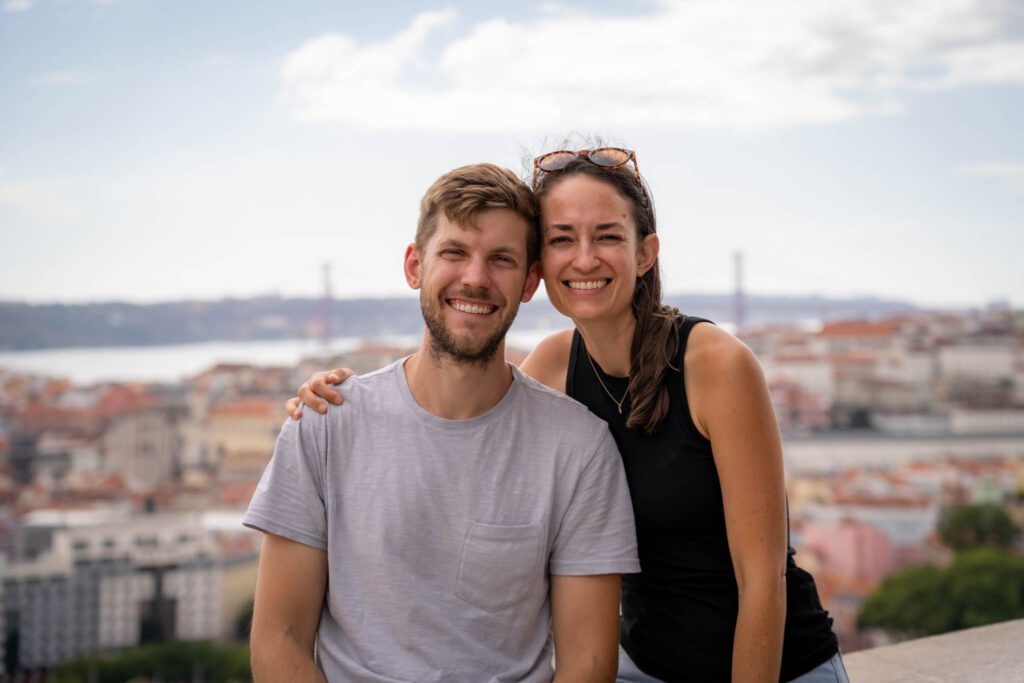

Disclaimer: Some of the links in this post, like hotel links, are affiliate links, meaning at no additional cost to you, we make a little bit of money if you click through and book. That being said, we would never recommend something to you that we don’t stand behind 100%.
Is 3 Days in Lisbon enough Time?
We think 3 days is a good amount of time for Lisbon. Obviously, three days is not nearly enough to see everything in Lisbon, but given limited vacation time, 3 days is a great introduction.
Lisbon is a fantastic city in and of itself, but there are a couple of great day trips from Lisbon that are also worth taking, which means adding an extra day or so (depending on how much time you have) to get outside of the city and see those spots.
3 days in Lisbon is the perfect amount of time to explore both the city of Lisbon, and take a day trip to Sintra, which would be our choice of the day trip options.
You can do it in two days, but we’d definitely cut out the day trip to Sintra and stay within Lisbon’s city limits. One day is a stretch (here’s how we’d spend one day in Lisbon), but you can see SOME of the sights in Lisbon – it’s a fairly compact city – so you’ll know what you want to see more of on your return trip.
Where to Stay in Lisbon
There are basically two neighborhoods we’d consider for a trip to Lisbon that is under five days, especially if it’s your first time.
We have an entire, detailed guide dedicated to the subject of where to stay in Lisbon. Read that for more information.
We stayed at Porta do Mar, a nice serviced apartment complex in Baixa within walking distance to, well, pretty much everything in Lisbon. Apartments have full kitchens, which is a main reason we stay in apartments (I have Celiac Disease and need to eat strictly gluten free – here’s my guide to gluten free Lisbon!).
If you’ve been to Lisbon before and are looking for a fun new place to stay, consider Bairro Alto (be warned – the nightlife is wild) or Principe Real.
Chiado
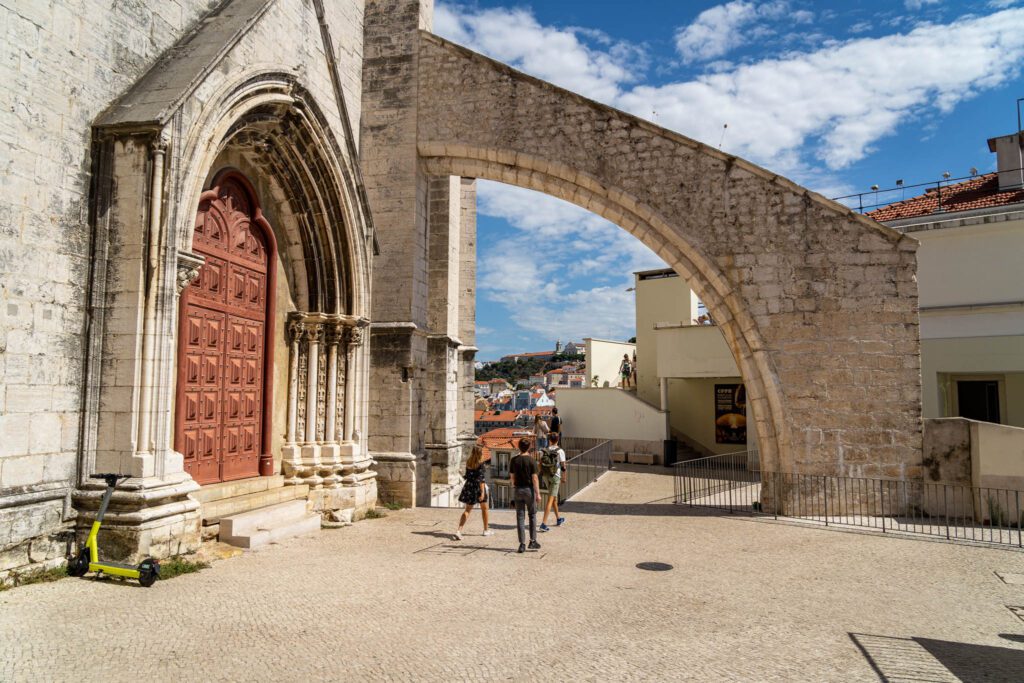
Chiado is about as central as it gets in Lisbon, which is why it’s our top pick for most people.
It’s conveniently positioned between Baixa down the hill, Alfama to the east, and Bairro Alto / Principe Real to the west. It’s also up the hill, so you won’t be walking uphill quite as much (although there will definitely still be plenty of uphill walking).
It also has its own metro stop, which you’ll be thankful for after long days of walking around Lisbon.
In Chiado, here are three places to consider – a hotel, a serviced apartment, and a budget option – depending on your style and budget.
- Want a hotel? Casa de Barao is our top pick in Chiado. It’s in a historic building from the 1700’s that was recently renovated, and it’s right in the heart of Chiado. Plus, the pool!
- Looking for an apartment? For groups of one to four people, we’d look at Lisbon Charming Apartments in Chiado, which have one and two bedroom apartment options at the north end of Chiado. For bigger groups, look at LV Premier Apartments, which have two and three bedroom options that can sleep between six and ten guests, depending on how comfortable people are sleeping on a sofa bed.
- On a budget? Look at Lost Lisbon’s Chiado House. They have rooms with private external bathrooms, which will save you a little bit of money without sacrificing on comfort.
Alfama
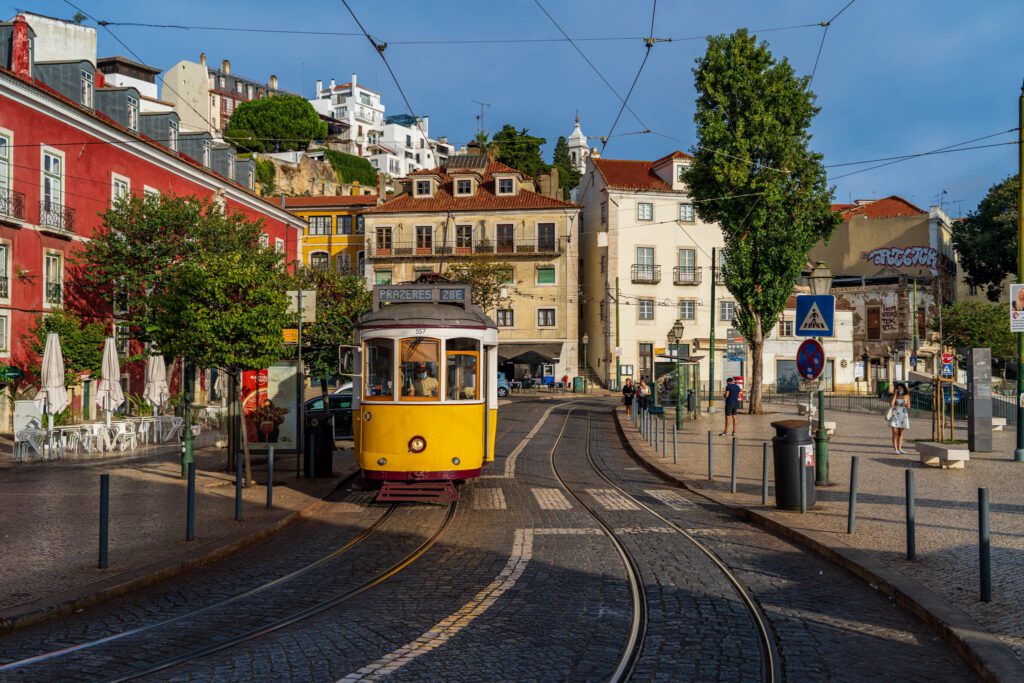
Alfama is set on the hill to the east of Chiado and Baxia, São Jorge Castle (Castelo de São Jorge) towering above the serpentine streets that snake their way downhill to the river.
This area is one of the oldest in the city and reminds me a lot of neighborhoods like Trastevere in Rome and Montmartre in Paris.
Those neighborhoods, along with Chiado, transport you back in time with their narrow, winding cobblestone streets and open plazas. It’s somehow simultaneously quiet and bustling, with a mix of people going about their business (like doing laundry) and people eating at open air cafes.
In other words, it’s uber romantic and charming, and would be a nice home base for a trip to Lisbon. However, it is up a hill from basically everything else in Lisbon, and public transit connections are strictly okay (the 28 tram runs through Alfama, but it’s usually packed).
Here are three places to consider in Alfama – a hotel, a serviced apartment, and a budget option – depending on your style and budget.
For what it’s worth, we stayed at the Porta do Mar Apartments for our first trip to Lisbon, and loved it. It’s in Baixa, but it’s two blocks from the Sé de Lisboa, which means you’re at the bottom of sprawling Alfama. The location was pretty much perfect.
- Want a hotel? The Hotel Convento do Salvador is set in a former convent that is steps away from Miradouro das Portas do Sol, one of the best views of the city (and a terrific place to sit on the terrace and have an Aperol Spritz at sunset). Rooms are compact, but comfortable, and for a little extra you can have a river view from your room.
- Looking for an apartment? For groups of one to four, look at Casas do Bairro Conqvistador, which is just outside the castle walls. They have one bedroom apartments with an option for a sofa bed to house up to four people. Bigger groups, look at Alfama – Lisbon Lounge Suites, which have a couple of two bedroom apartments that will give you a little more space.
- On a budget? The rooms at Archi-Pelago Alfama Design Suites are small, but have everything you’ll need for a comfortable stay. There’s a range of room types and sizes, so you can pick the right one for your style and budget. Plus, the rooms are gorgeous, filled with natural light and design elements reminiscent of places where you’d pay triple the amount it’ll cost you to stay here.
A Complete 3 Day Lisbon Itinerary for First Timers
Now let’s talk about exactly what to do with your time in Lisbon. We arrived in Lisbon late at night, and we’re going to assume you have three full days to explore the city, NOT INCLUDING your travel days (arriving in Lisbon, and leaving Lisbon).
If you have less time, we have some ideas on how to compress this Lisbon itinerary into one or two days in Lisbon below the main itinerary.
A note on our travel style before we get into it – we’re not huge museum people, nor are we into going inside every single church in the city (there are too many to cover in Lisbon anyway, in a country that is still over 80 percent Catholic).
We’re far more into experiences that connect us with locals who can show us their version of the city, which is why you’ll find a walking tour (we LOVED this walking tour, which we did on our first day) and a food tour on our Lisbon itinerary rather than a list of six churches and three museums.
Different strokes for different folks, I suppose, but we’d much rather spend our time going deeper on fewer things than running around from tourist sight to tourist sight trying to see it all.
Day 1: Walking Tour + Baixa, Chiado, and Alfama
Spend your first day in Lisbon exploring the main tourist center of Lisbon that includes Baixa, Chiado, and the most romantic and charming part of Lisbon, Alfama.
But First, Coffee

Lisbon has a surprisingly vibrant specialty coffee scene, which is music to my ears. I love coffee, and especially love experiencing coffee in new ways – whether that’s a new drink, beans from a place I’ve never tried before, or new flavors or processing.
I’m a little bit of a coffee nerd, so during our time in Lisbon I went on a quest to find the best coffee in Lisbon.
Here are the two places I’d recommend that are near the center of Lisbon.
- Bloom Coffee Room: They curate the best beans from around Europe, and you’ll find roasters from Berlin, Barcelona, Amsterdam, and other places even further afield. The best coffee we had in Lisbon came from this place.
- Fábrica Coffee Roasters: They have multiple locations around the city, and are building a specialty coffee empire in Portugal (now they have a location in Porto, too). They roast their own beans, and the cappuccino we had there was the best we had in Portugal.
Get Oriented with a Walking Tour
We really, really enjoy doing a walking tour on our first day in a new city to get our bearings, connect with a local who can help us learn the language and give me some pointers on what to do, see, eat, and drink, and check out some of the main sights to give us an idea of what want to come back to.
We have two options for you here – we did both ourselves and liked them, obviously, or we wouldn’t be recommending them to you.
The tour we did is the “Lisbon Highlights and Hidden Gems” walking tour with Withlocals, a tour company that we’ve fallen in love with in Europe, and have basically used in every city we’ve visited over the last few months where tours are available.
They’re perfect because they’re private tours (at regular tour prices, I might add, especially if you have more than two people), and thus they’re customizable to your particular needs and interests.
We did a tour with Isabel in Lisbon, and highly recommend her as a guide.
Shoot for a tour that starts around 10:00 am, which means you’ll be done and ready to go by 1:00 pm.
It covers many of the sights between Bairro Alto and Alfama, all with a professional guide who knows far more about the city than any guidebook, and who can help you with restaurant recommendations, things to know about the city, getting around, and more.
Plus some fun anecdotes (and some not-so-fun) and history lessons along the way! We really enjoyed it, and think you will too.
Click here to book your walking tour
Lunch + Pastel de Nata in Chiado
Head to Chiado for lunch on your first day in Lisbon. It’s the most central neighborhood, and there are some great places to eat in the area.
We’d opt for seafood at Pinóquio (technically in Baixa), vegan food at The Green Affair, or pastel de bacalhau – a cod, potato, and cheese pastry – at Casa Portuguesa do Pastel de Bacalhau washed down with a nice port wine.

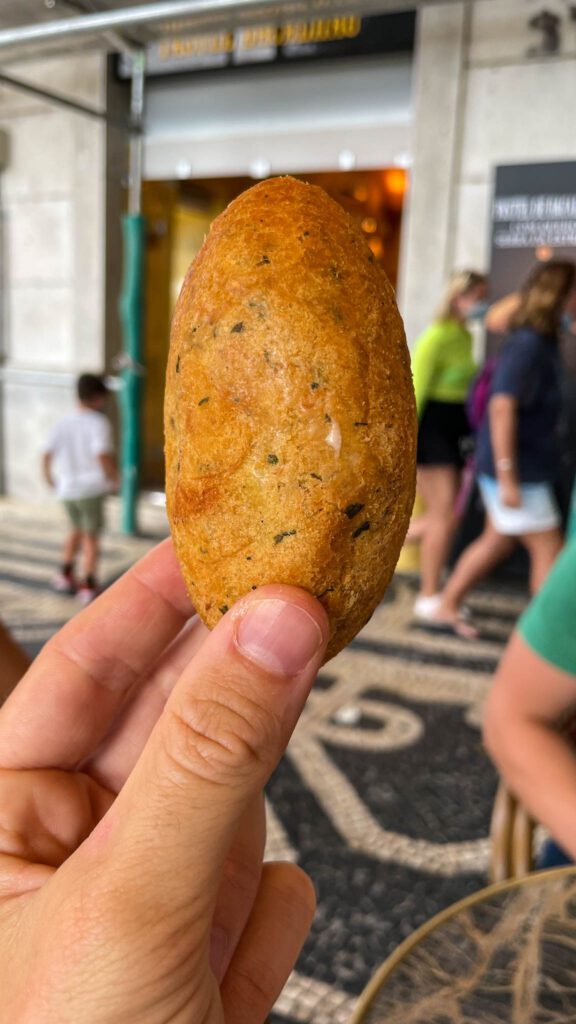
After lunch, it’s time for a quintessential Lisbon experience: pastel de nata! Pastel de Nata is a staple on any Lisbon itinerary. It’s essentially an egg custard tart, enveloped in a crispy, crunchy, flaky crust.
The best we found in Lisbon – and our waking tour guide agreed with our assessment – is at Manteigaria.
They’re best when they’re warm, and you’ll want a nice dusting of cinnamon on top (which they will provide).
Aloma, right across the street, was our guide’s second favorite spot. Try both, and compare for yourself!
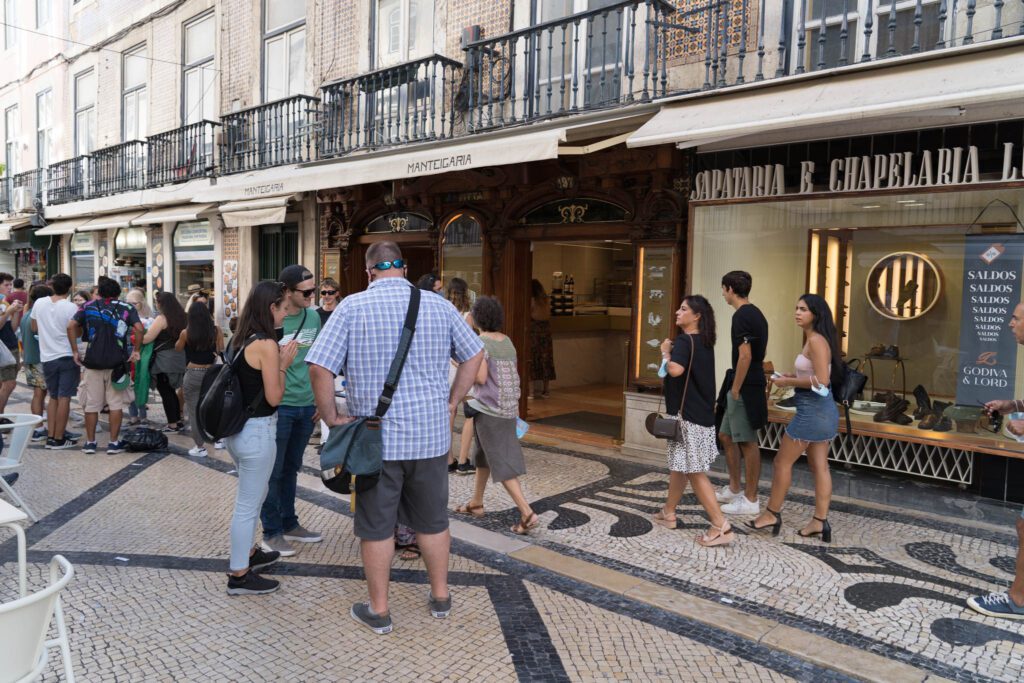

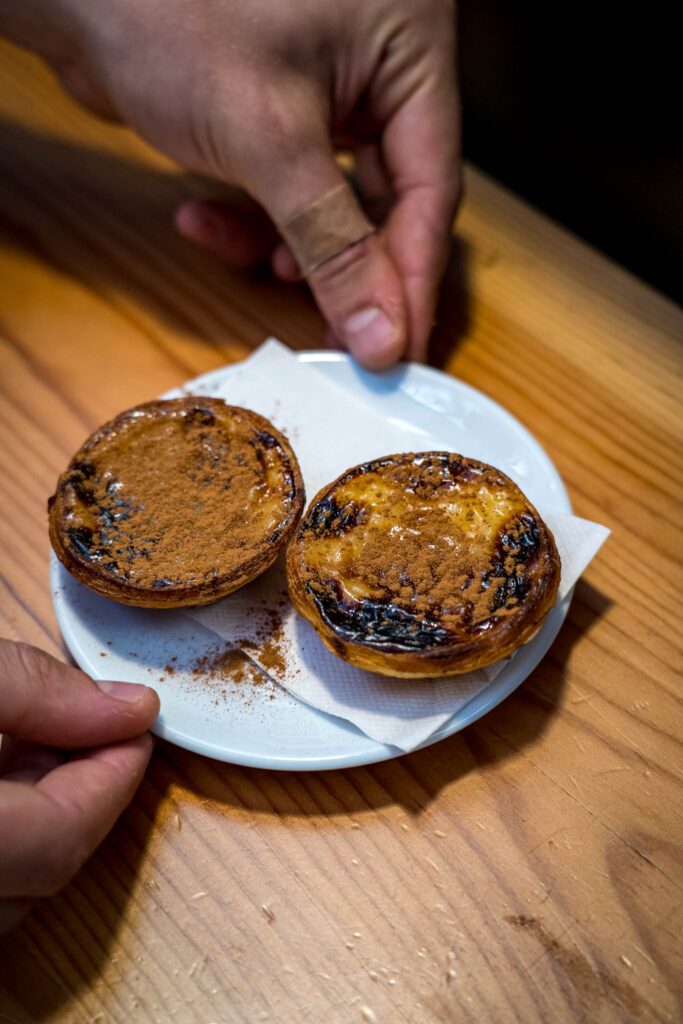
Afternoon: Exploring Alfama
After lunch and doing a bit of poking around in Chiado, head to the most romantic part of the city, Alfama.

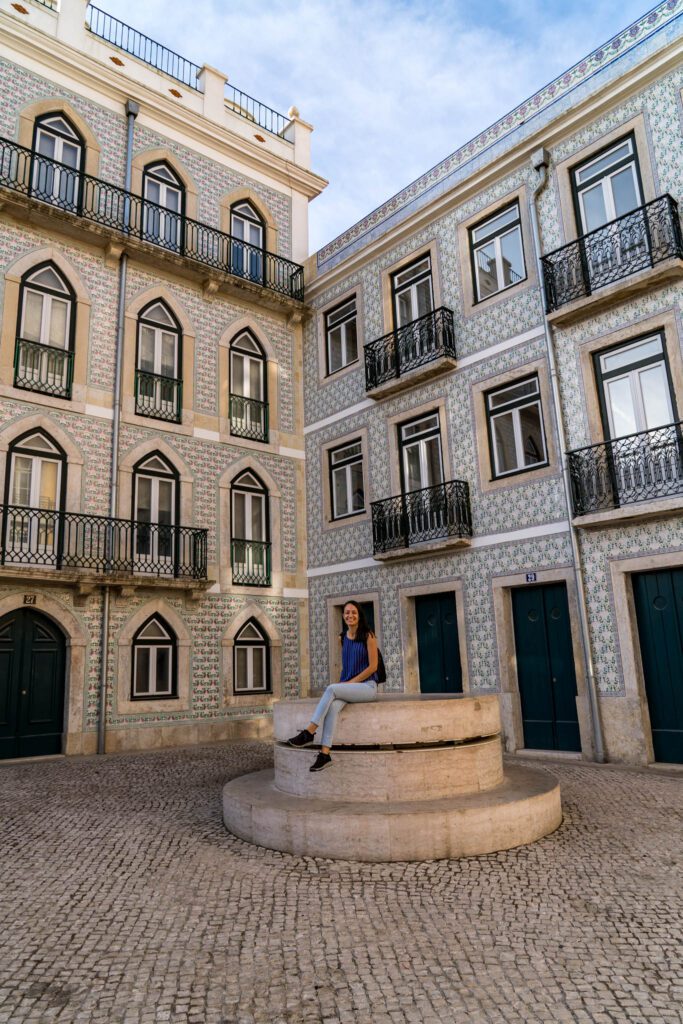
Alfama is the oldest feeling part of the city, with narrow cobblestone streets that wind their way down from the Castelo de São Jorge at the crown of the hill. It’s also home to several of the best viewpoints in all of Lisbon, which you should definitely make an effort to get to.
Here are a few suggestions of things to do and see in Alfama. My advice is to start near the top of the hill with the castle, then make your way downhill from there to the Lisbon Cathedral (Sé de Lisboa).
You can ride the 28 tram up the hill and walk back down if climbing up to the castelo on your own two feet doesn’t sound like your idea of fun.
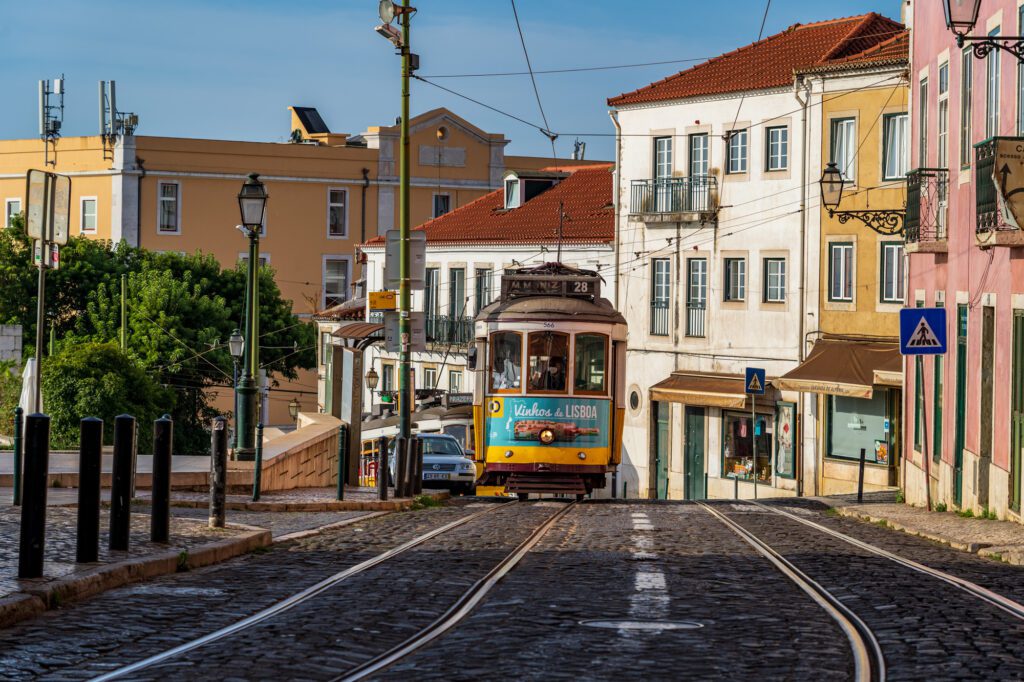
One note: your next stop is actually further up the hill from the miradouros (to another miradouro and some pre-dinner drinks), so plan on heading uphill from the miradouros. It’s a little bit of backtracking, but we think it’s worth it for one of the best views in all of Lisbon.
Castelo de São Jorge

The castelo sits on top of the hill, with Alfama sprawling down the hill from its walls towards the river. It used to be an important defensive position, and was the scene of many battles over the centuries before the Portuguese took Lisbon and established it as their capital.
Since then, it has been many things, including a hospital and a prison, and only in the 20th Century was it restored to its former glory.
Today, you can visit the grounds (it costs 10 Euros) and, most importantly, walk on the castle walls for some amazing views.
Miradouros Galore
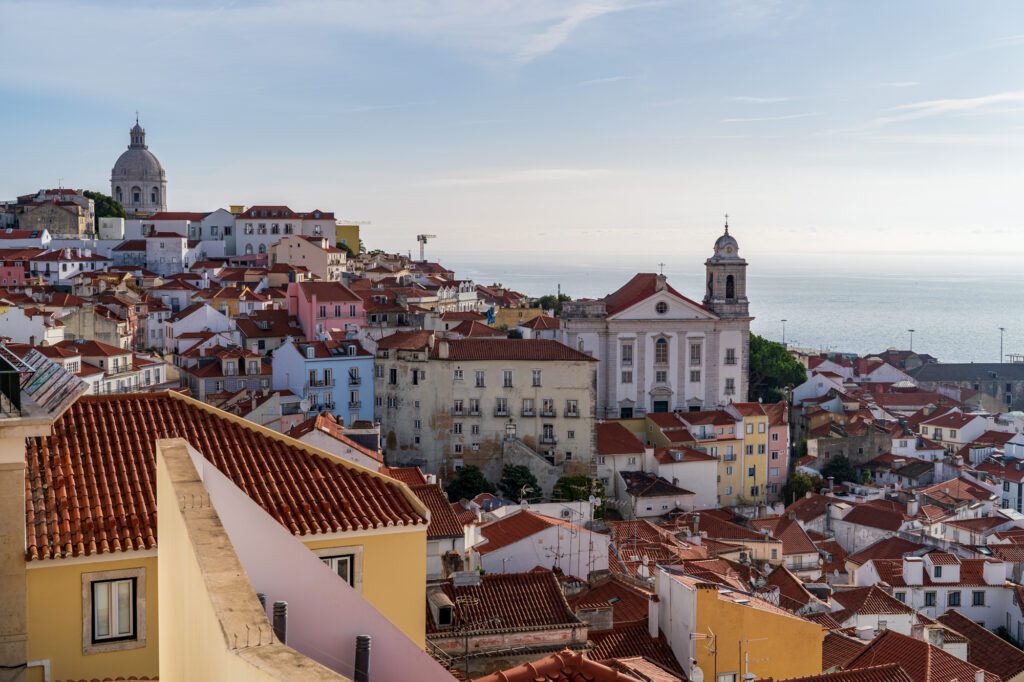
There are several great viewpoints in Alfama, including two that are just a few blocks away from each other.
Miradouro de Santa Luzia (here on Google Maps) is the first, and it’s a nice view out towards the river. There are some cool tiles to check out on the side of the Igreja de Santa Luzia (right next to the viewpoint) depicting a battle for the Castelo.
The second is Miradouro das Portas do Sol (on Google Maps here), which has even better views out towards the Tagus River, including the Igreja de São Vicente de Fora out to the northeast on the hill.
Don’t miss the statue of St. Vincent, the patron saint of Lisbon. The latter viewpoint has a nice little outdoor terrace with a bar, which would be a lovely place to enjoy, say, an Aperol Spritz or a Port Tonic while watching the sun’s golden glow light up the hillside.
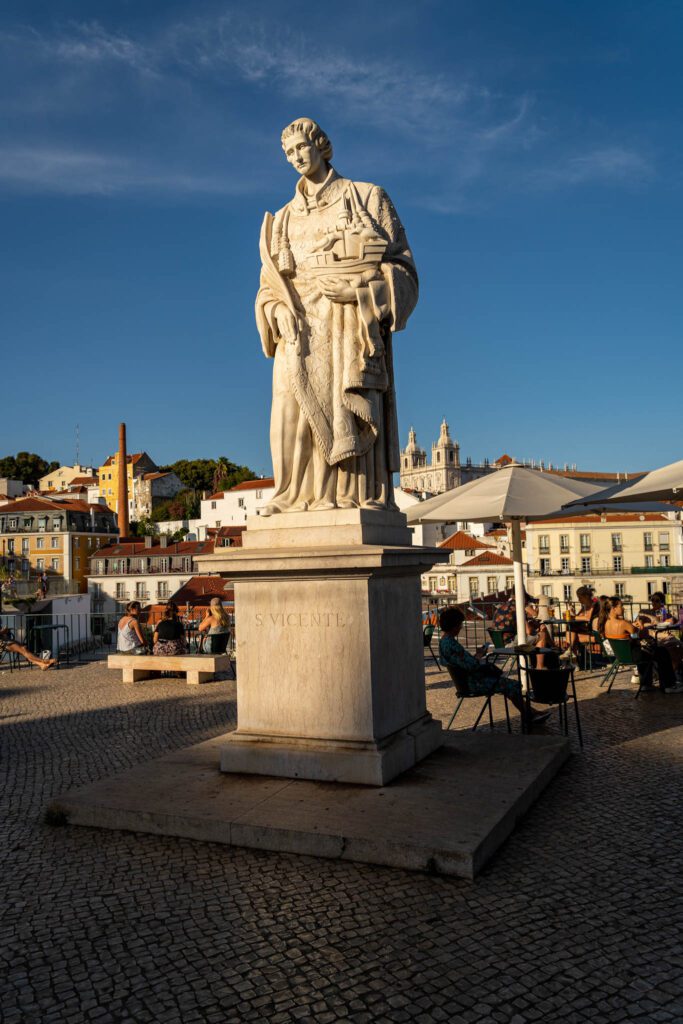
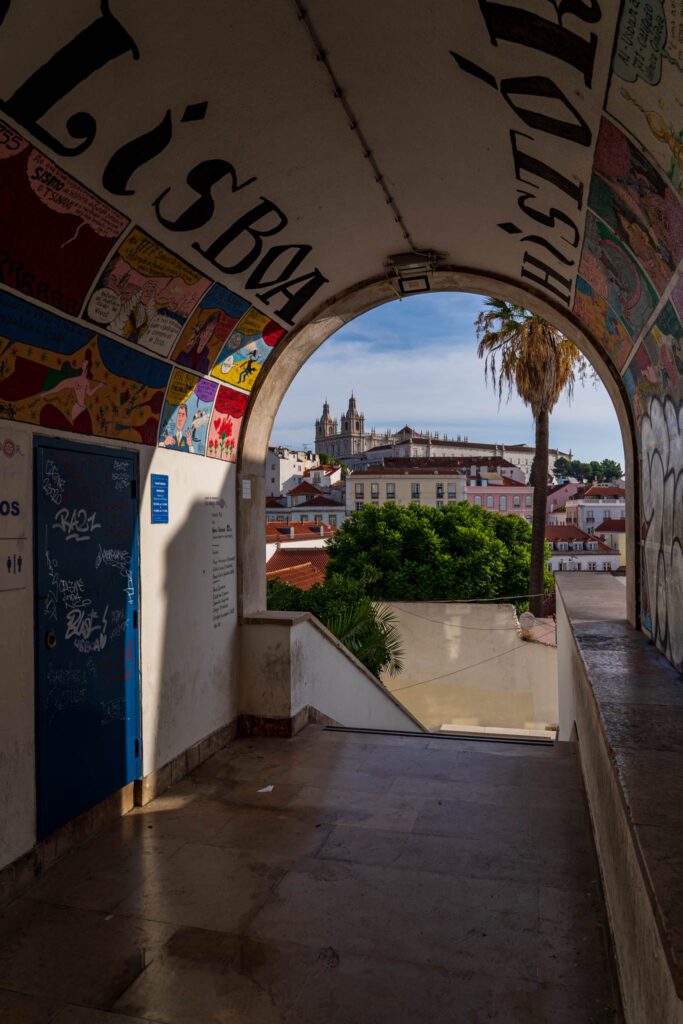
Miss Can
When in Lisbon, you should try canned fish at least once, even if you think it’s not your thing. And we think Miss Can is the place to do it.
It’s owned by a woman whose family has been in the fishing industry for generations, and she does the work to ensure her product is sustainable, from the fish to the cans.
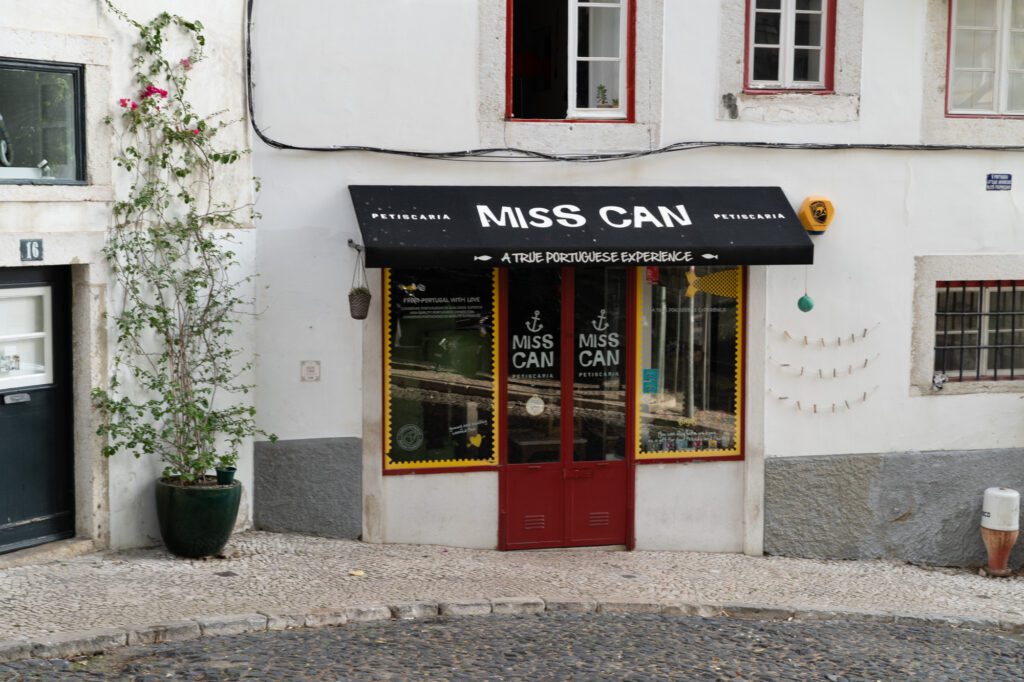
We tried a bunch, and really, really liked the bacalhau (that’s cod) in garlic and olive oil. It was the least “fishy” option if you’re not a huge fan of fish flavors. You can either get some to enjoy at the small restaurant, or pick up some cans to enjoy later.
They also make great souvenirs to bring home for friends and family.
On our return trip to Lisbon a few months after our first visit, we came back and bought about seven cans to bring home to friends, all of whom absolutely loved them (and some even ordered their own to ship all the way to the United States).
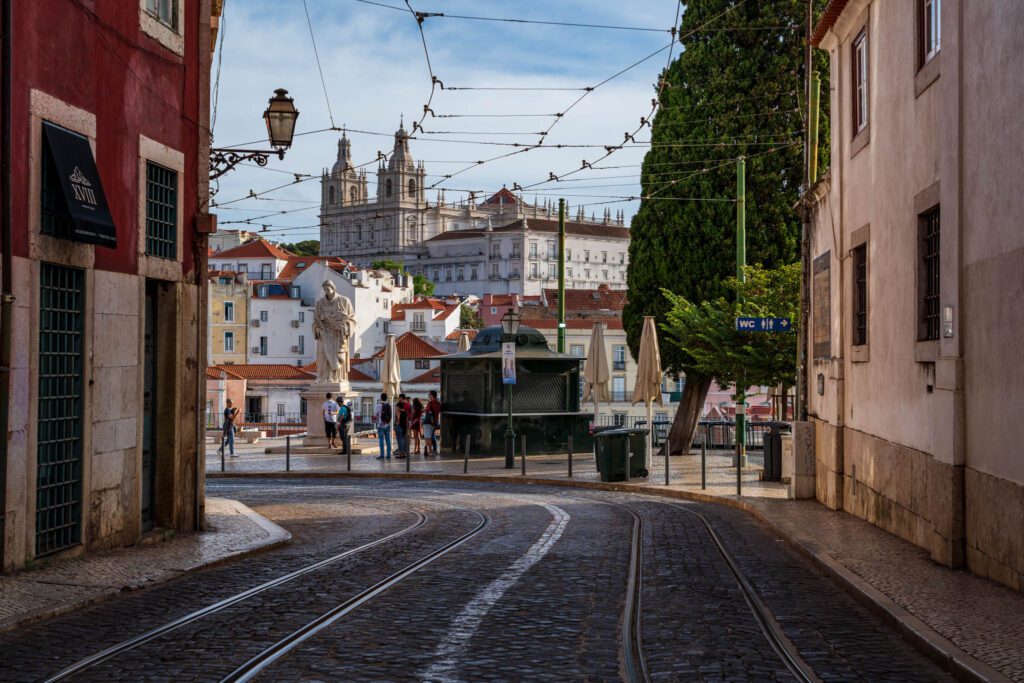
Pre-Dinner Drinks in Graça + Dinner Back Down the Hill
Rather than head down the hill after doing some exploring of Alfama, make your way to nearby Graça to get some drinks before dinner in Alfama on your journey back down the hill.
First, head up to take in what might be the best view in all of Lisbon at Miradouro da Senhora do Monte. Fair warning, it’s quite the hike, but it’s worth it. See?
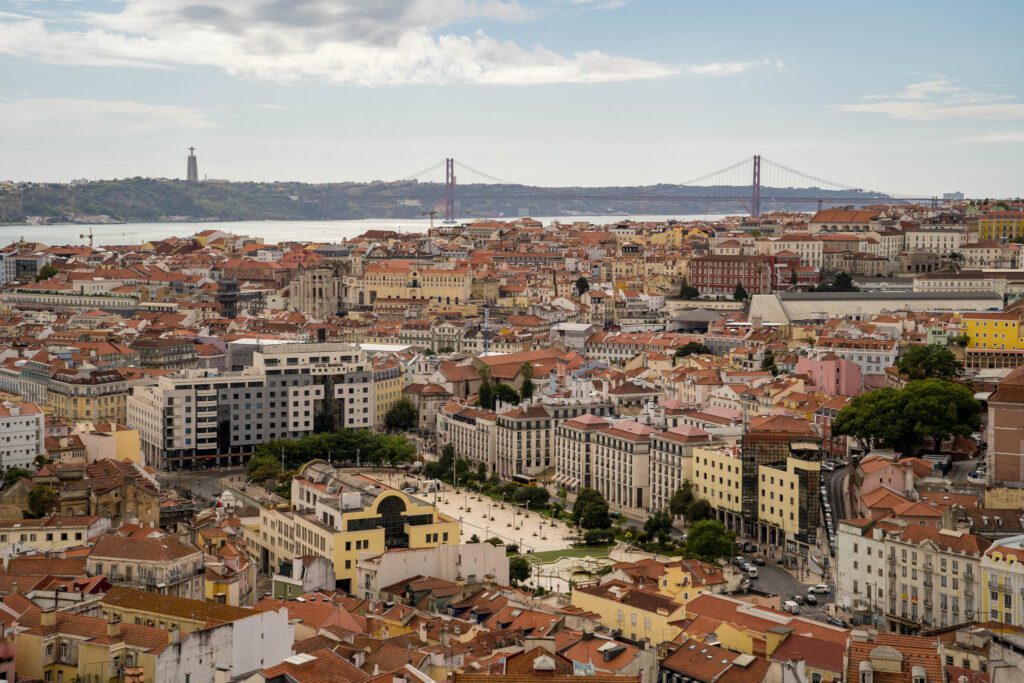
Then, check out either 8a Graca for some of the best craft beer in Lisbon, or down the hill to Graça do Vinho for an extensive selection of Portuguese wines and some light snacks (think bread and cheese).
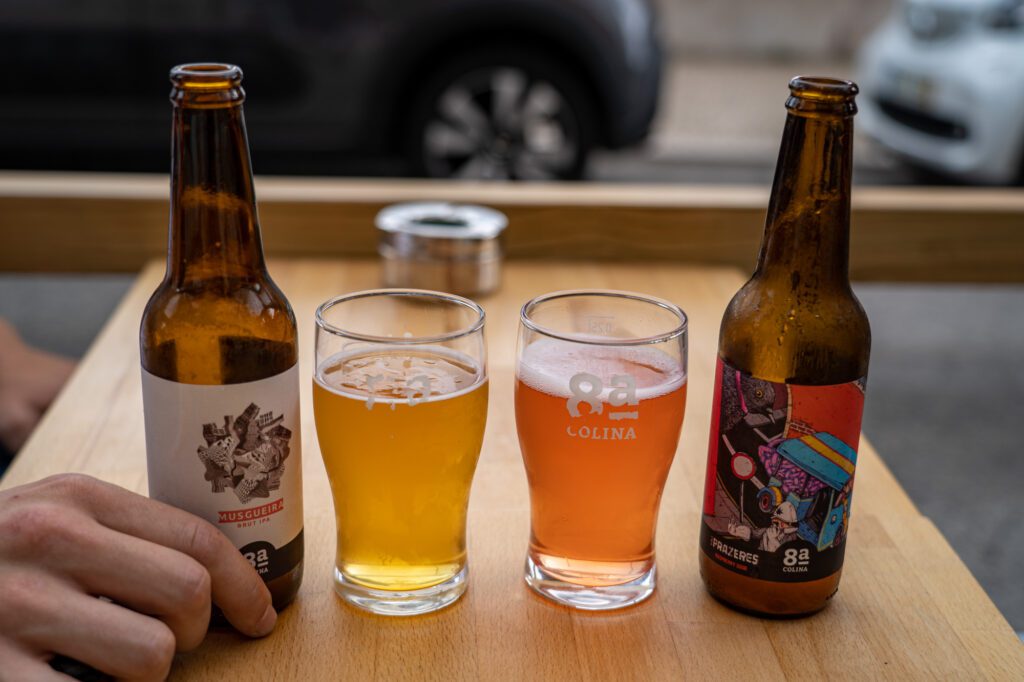
For dinner, there are A LOT of very touristy, very overpriced restaurants in Alfama, as our tour guide warned us. If you choose one of those, you’ll pay for the atmosphere, and the food won’t be great. Here are three alternative suggestions that are all in Alfama, but are actually highly rated.
Day 2: A Food Tour + Belém
On your second day, explore the delicious world of Lisbon’s food scene before hopping on the tram for a short ride out to Belém, home to a couple of cool sights (and one important taste).
A Food Tour of Lisbon’s Best Flavors
If, like me, you have Celiac Disease (which means I need to eat strictly gluten free), then this tour isn’t for you. If you don’t have Celiac Disease and you love food, then you should take a food tour with a local who will bring you to places where you can try some of Lisbon’s authentic flavors.
This is the tour we’d recommend, though – disclaimer – we haven’t done it ourselves. It has 4.95 stars and over 4,000 reviews at the time of writing, which puts it among the most highly rated tours I’ve ever personally seen on Airbnb before.
And the CEO of Airbnb has done the tour, which should tell you something. You’ll taste everything from fish to liqueurs, and do it at small, family-owned places that you wouldn’t otherwise find on your own. Plus, it’s plastic free!
Catch the 10:00 am tour and show up hungry. Seriously. Don’t eat beforehand. You should be done by about 1:30 pm, when you’ll be ready for either a nap, or a trip out to Belém.
An Afternoon in Belém

After your food tour (and a nap?), head out to Belém for an afternoon and evening of fun.
Belém used to be a separate city, but as Lisbon has expanded it has swallowed it up and now it’s a district within the broader city of Lisbon.
It’s right along the river, and is home to several cool sights, including the Torre de Belém, a huge monastery, and, perhaps the most important, Pastéis de Belém, which is said to be the birthplace of the original pastel de nata.
Today, the entirety of Belém is a UNESCO World Heritage Site.
In Belém, we’d recommend starting at the furthest end with the Tower of Belém, then working your way back towards Lisbon.
Getting to Belém
The easiest way to get there from the center of Lisbon is to hop on the 15E Tram from around Praça do Comércio.
It takes about half an hour each way, and costs three Euros in either direction. You can buy tickets on the tram, but you have to use the machines which sometimes don’t work AND only accept coins and require exact change.
You should either get a Viva Card (see the “Getting Around” section below the itinerary for more detail) at one of Lisbon’s Metro Stations so you can tap on / off with less hassle, or today might be a good day to invest in a 24 hour pass for the metro, buses, and trams, which will set you back 6.40 Euros.
Torre de Belém
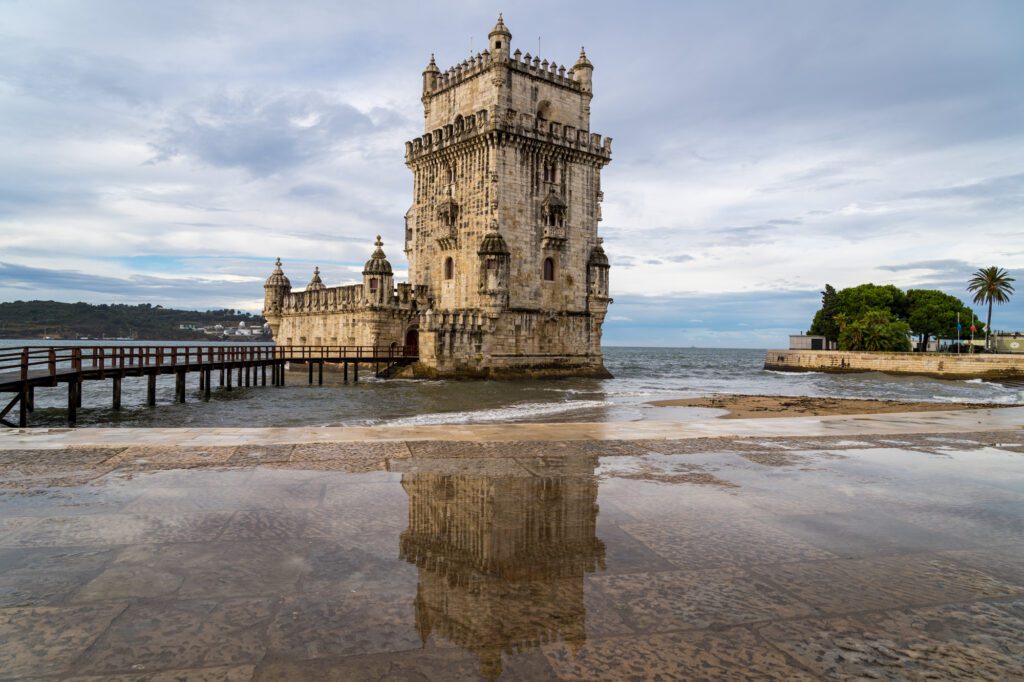
First of all, don’t go up into the tower. We just saved you 6 Euros a person. Lines are long, and the view from the top isn’t really worth the money or the time it’ll take you to get there.
It is, however, worth admiring from the outside. It was built in the 1500’s for two reasons – to serve as an entry / exit point for people coming in and out of the city by ship, and to serve as a coastal defense for Lisbon, as it’s ideally placed along the banks of the river near the mouth to fend off any attacks.
Unfortunately, it didn’t do so well on the second front. It was taken in 1580 by the Spanish. But it was upgraded following that catastrophe, largely living out its days as a prison until it was made a UNESCO World Heritage Site in the 1980’s.
More information on the tower, including tickets, here.
Padrão dos Descobrimentos

Wander along the waterfront heading east to head to the Monument of the Discoveries (in Portuguese, Padrão dos Descobrimentos), which is a tribute to Portugal’s amazing history of explorers. Do you remember from fourth grade who the first person to circumnavigate the world was?
I didn’t, but our walking tour guide was quick to remind me that it was Vasco da Gama, and we actually visited the town where he was born just outside of Porto later in our trip to Portugal. Funny enough, that town is definitely inland, not along the sea at all.
Vasco da Gama is one of the figures featured in the depiction on the side of the monument, which was built in the middle of the 20th Century under Portugal’s dictator, António de Oliveira Salazar, who was really into romanticizing Portuguese history.
Naturally, the Age of Discovery in the 15th and 16th Century was near the top of the “aren’t the Portuguese people great?” list, which is problematic because let’s be real for a second – all of the places they “discovered” were… already discovered. Just not by people with white skin.
We’re not going to solve that issue here, so I digress.
Anyway, the square in front of the monument is beautiful, with art made from limestone tile donated by South Africa, and the towering monument that rises 171 feet over the river.
You can go inside, but we’d skip it, and instead just admire it from the outside.
Jerónimos Monastery
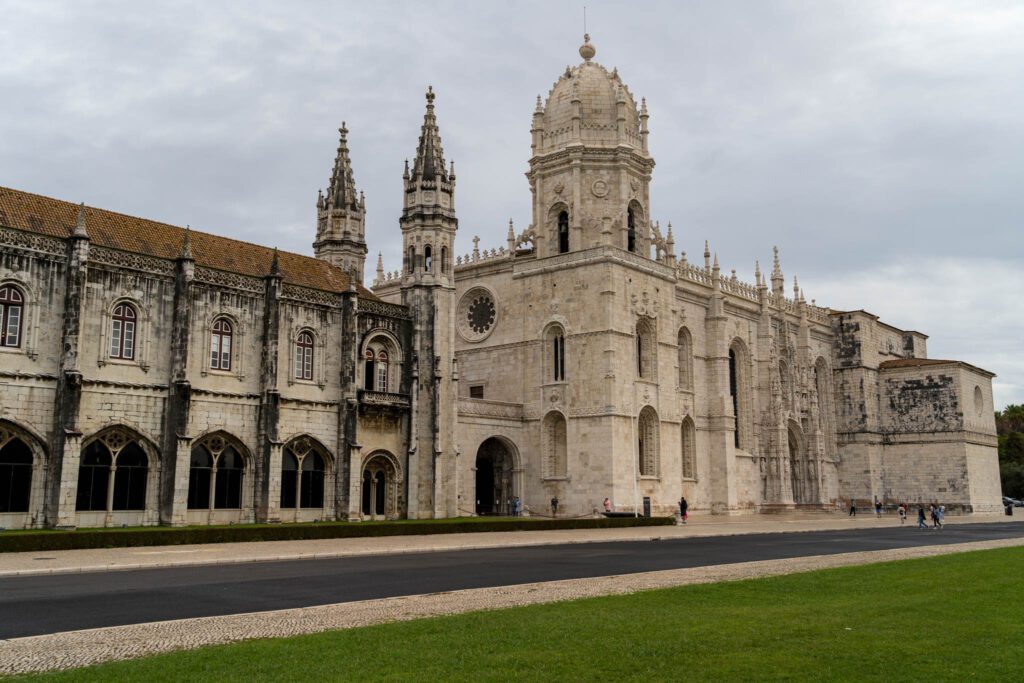
The monastery (and the garden across the street) are worth a visit too. It’s a former monastery – meaning it’s not active today – and housed monks from the order of Saint Jerome (hence, the name).
It’s a great example of typical Late Gothic Manueline architecture in Lisbon, which was created in the 16th Century during the Age of Discovery, and incorporates maritime symbols – ships, shells, and seas – into the Gothic style.
It’s typical in Lisbon, and there are a bunch of statues and examples of it around the city, including the statue of St. Vincent in Alfama, who is the patron saint of Lisbon and is holding a ship with two ravens, which is the coat of arms of Libson.
Like I said, Maritime elements galore.
Construction started in 1501 and took over 100 years to complete, which should tell you something about the grandness you’re about to witness. It’s free to enter, but you have to pay to go into the cloister, which is pretty impressive, but not necessarily worth the money.
Pastéis de Belém
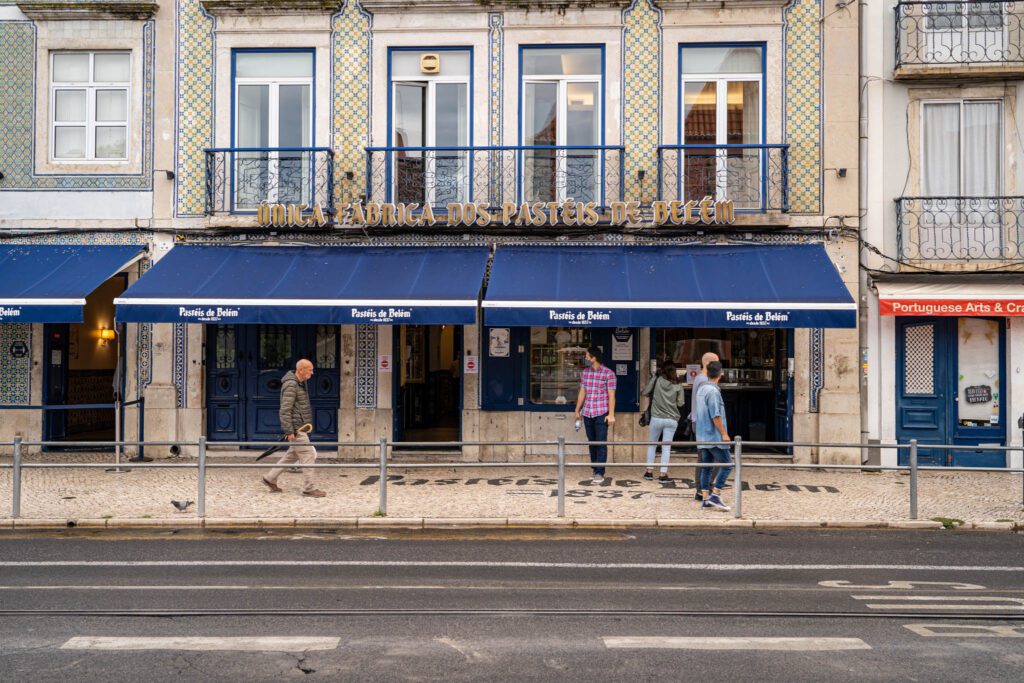
Head about a block east from the monastery to your final stop in Belém – the birthplace of the pastel de nata. Allegedly, anyway.
The legend goes that the pastel de nata was created by monks from the monastery wayyyy back in the early 19th Century. And the story is actually fascinating, and completely plausible.
Next to the monastery, there was a sugarcane factory, and after the revolution in Portugal in 1820, all convents and monasteries were shuttered in 1834, which meant that the monks had nowhere to go, and no way to make a living.
Before that, they bought A TON of eggs (the whites were used for starching robes) and found themselves with some leftover egg yolks, so they started making sweet treats as a little bit of a side hustle (and probably, more importantly, to enjoy themselves).
Ever the entrepreneurs, they sold that recipe to the pastry shop – the same one that exists there today – using that handy dandy sugarcane factory and those eggs. Guess what the two main ingredients are in those pastries? Sugar and eggs.
They started pumping out these “Pastéis de Belém” – which would eventually become known more broadly as “Pastéis de Nata” – and two centuries later, the recipe and methods are said to be almost exactly the same as they were back in the 19th Century.
They’re so serious about their brand that only the pastéis that come out of this kitchen can legally be called “Pastéis de Belém” – the original.
Part of me wonders how much of that story has been romanticized over the years, and how similar the recipes really are today. The other part of me says “yeah, that’s a good story, let’s go with that.” But are they really the best? Here’s a completely subjective and unscientific take.
Everyone says to go here for the best pastel de nata you’ll have in Lisbon. So we put it to the test. And by “we” I really mean my two brothers and Alysha. No gluten for me.


The results? This one came in second behind Manteigaria. The crust was the best out of the three we tried, giving the pastry a nice texture contrast between the crispy outside and the ooey-gooey custard, but the custard was the downfall here, which was less flavorful than the ones they had tried previously.
Still, well worth a stop when you’re nearby. The more cinnamon, the better.
LX Factory

On your way back to the heart of Lisbon, make a pit stop in Alcântara to check out LX Factory.
When you walk through the entryway here, you might feel like you’re in a hip part of Los Angeles or Brooklyn. And that’s kind of the vibe they’re going for, if we had to guess.
In the mid 19th Century, this area was home to an important textile factory. Today, it’s an outdoor hub of different shops, bars and restaurants, and small businesses who have all come together to create one of the most engaging, creative, and unique places in the entire city.
You’ll find a nice bookstore, a great wine shop, countless restaurants, and plenty more. Here were some of our favorite stops (though we think you should take your time and explore for yourself).
- Livraria Ler Devagar: You’ve probably seen this one on Instagram, with the big art fixture hanging from the ceiling of a person on a bike with their scarf trailing behind them. It’s a huge bookstore with a small English language section, a record shop on the first floor (that’s the second floor, to us Americans), and some cool old printing presses on the top floor that are worth checking out.
- More Than Wine: We found both wine and cider that we liked here, but they also sell things like chocolate, jam, honey, and ceramics.

We visited LX Factory in the morning, which we realized was not the right time to be there, and we ended up thinking to ourselves “I bet this place would be cool at night.”
That’s why we have you stopping here on your way back – because we think it’s worth grabbing dinner and drinks here, where you’ll have options ranging from Mexican food to gourmet hot dogs or sushi.
Day 3: A Day Trip to Sintra

On your third day, take a day trip from Lisbon out to Sintra, home to Pena Palace and a couple of other worthwhile sites.
Things to Know About Visiting Sintra
The first thing you should know is that Pena Palace, which is a must-visit and is the most popular site, is at the top of a steep hill if you’re coming from the town of Sintra. We strongly recommend that you make Pena your first stop of the day, and make your way down the hill from there.
There are a couple of different ways to get from the train station up to Pena Palace.
- Bus: There are a couple of bus options leaving from the same general area. To get to Pena Palace, you want the 434, which takes you from right outside the train station (exit the station and turn right around the corner, towards the tourism office – here’s a map) up to Pena Palace. It costs 3.90 Euros for a single ride (e.g. from the station to Pena Palace), and 6.90 Euros to get a hop-on, hop-off ticket that allows you to ride the bus there and back (but only in one direction). Here’s a helpful guide.
- Taxi / Uber: If you have two people or more, this is the best way to do it cost-wise. The bus is crowded and lines are long, so if you’re okay with walking down from the top, hop in a cab or Uber, pay the 10-15 Euros to get to the top, and you’ll likely beat everyone else up there.
- Tuk Tuk: We had a group of four, and as we were debating what route to take, a friendly tuk tuk driver pulled up and asked if we wanted a ride to the top for 20 Euros. Now, normally, we’re all for taking public transportation, and we’ve never actually taken a tuk tuk (except Alysha in Thailand). But for whatever reason, we were in a touristy mood, so we did it! It wasn’t exactly the fastest ride (though we did beat the bus), and there were times where I was pretty certain we were going to have to get out and push. But, alas, we made it to the top right as the Palace grounds opened and had some laughs along the way!
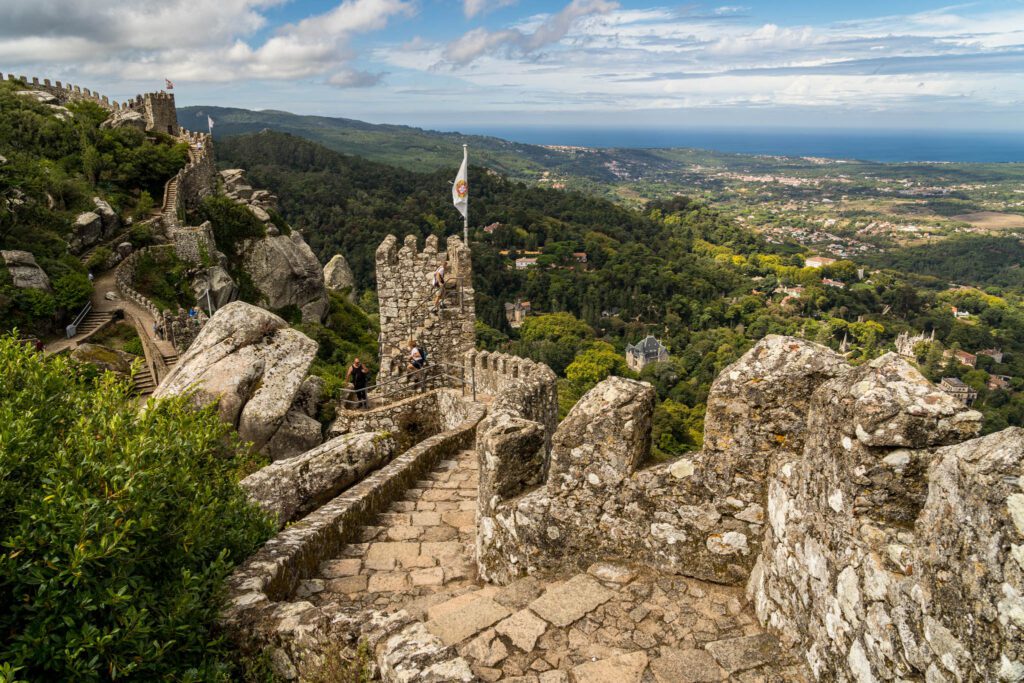
Getting to Sintra
Sintra is an easy 45 minute train ride from Lisbon’s Rossio Station in Baixa. Getting to Rossio is pretty easy from basically anywhere in Lisbon, including Baixa, Chiado, and Alfama.
The most important thing to know is that you will want to be on the first feasible train out to Sintra, which totally depends on how early you want to wake up.
The train we chose left at 8:11 am, which we think is the perfect time because you’ll arrive in Sintra around 9:00 am, and most of the attractions open at 9:30 am, giving you about 30 minutes to get up the hill to Pena Palace to start your day and beat the rest of the visitors.
What to Do in Sintra
Here’s the thing – there’s actually A LOT to do in Sintra. So much so, that you’re definitely not going to be able to comfortably fit it all into a single day, which is likely the amount of time you have.
For context, we were on one of the first trains out to Sintra, and didn’t make it back to the city until somewhere around 3:00 or 4:00 pm. And we only really did a couple of the many tourist attractions in Sintra.
We would suggest picking two or three things that you’re most interested in, and tackling those two plus the town of Sintra, which has some good places to eat and drink.
We also obviously have an opinion on what you should focus your time on, and we think the two sites you should choose are Pena Palace and the Moorish Castle.
Both offer different experiences – one is an opulent palace with fertile gardens, one is a replica of a former, you guessed it, Moorish Castle with spectacular views out over the ocean.
If you want to add in a third sight, we’d recommend the Quinta da Regaleira. We’d do the two aforementioned sights before lunch, making your way down the hill as you go, having lunch in the town of Sintra, then doing the 10 minute walk out to the Quinta da Regaleira before heading back into town to catch the train back to Lisbon.
Strap in, bring water and snacks, and prepare yourself for a full day affair.
Here are some more details on the Pena Palace and Moorish Castle.
Pena Palace
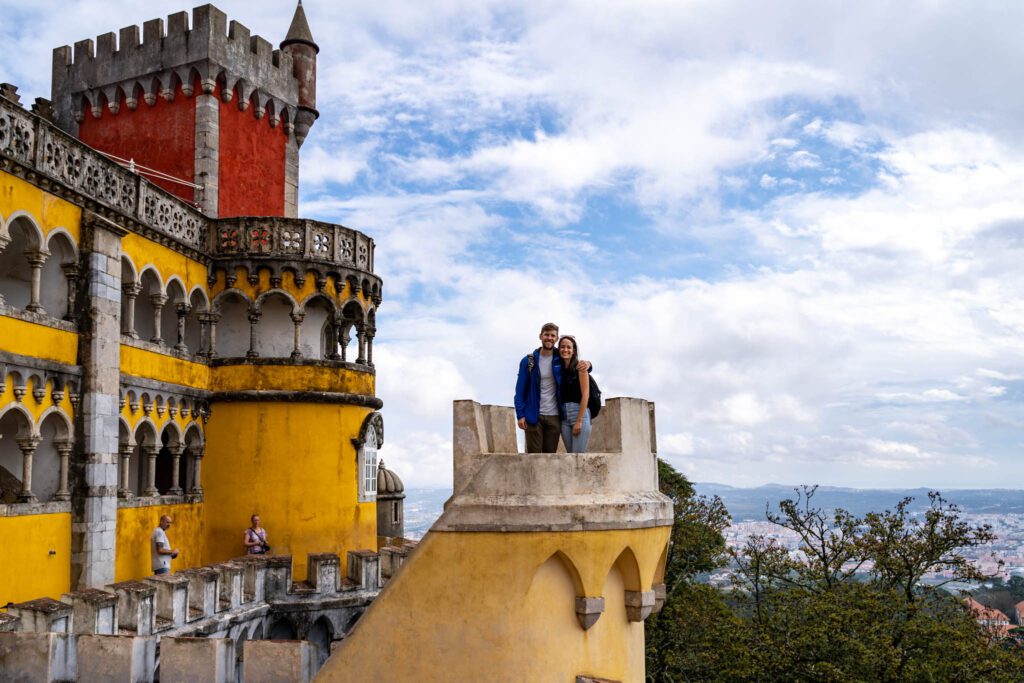
There are two parts of the Pena Palace complex, and they require different tickets.
There are the gardens, and then there’s the interior. We decided to skip the interior – we’ve seen plenty of opulent palaces over the course of our travels, maybe the rich dudes should have spent the money that they spent on their summer home on something, I don’t know, more useful?
Seriously, Pena Palace is essentially a summer home, built in the Sintra Mountains by King Ferdinand II. Originally, it was a monastery on the hill, but it was destroyed during the 1755 earthquake and sat there in disrepair for years.
Then, Ferdinand said “wouldn’t it be great to have a place to escape the oppressively hot Lisbon summers? Maybe a place on a hill, with nice views and a cool coastal breeze?”


12 years later et voilà! Pena Palace, built by German architect Wilhelm Ludwig von Eschwege. Eventually, the state of Portugal bought the palace from the royal family (honestly, isn’t that insider trading or something?) and turned it into the museum it is today.
The colors and décor of the palace are pretty unusual. Just look at this odd guy sitting atop one of the arches on the exterior of the castle.
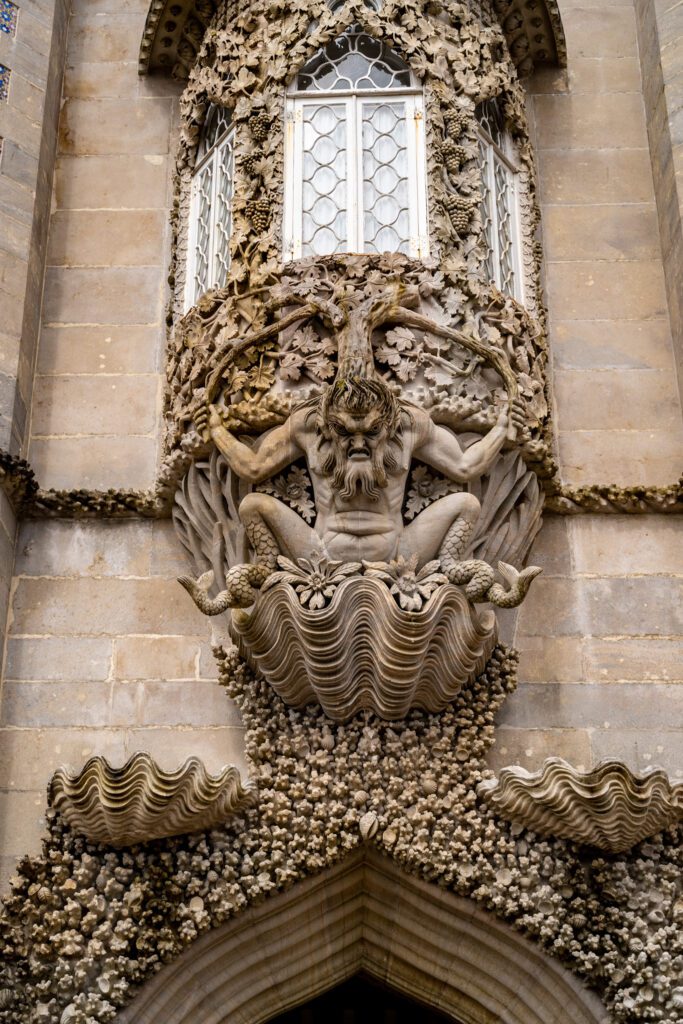
It’s an unusual mix of architectural styles, borrowing from multiple different eras and styles to create a multicolored mishmash.
We would recommend just getting a ticket for the grounds, and admiring the palace from the outside. Here’s how we’d spend your time:
- Start by exploring the gardens. When we arrived, the palace was fogged in and you could barely make out the bright yellow facade. If you find yourself in the same boat, fear not! It will likely burn off. Head out to the High Cross in the gardens, which is a nice view (if the fog happens to be gone – it wasn’t when we were there). In general, our favorite part of the gardens was the lakes area at the bottom of the hill.
- Then make the walk up to the palace. Admire the arches and tiles along the outside, and go up into the chapel, which is free.
- Walk the walls of the palace. There’s a short path around the palace walls, which you should save for last because it’s a great view out over Sintra and all the way to the coast, so you want it to be clear.
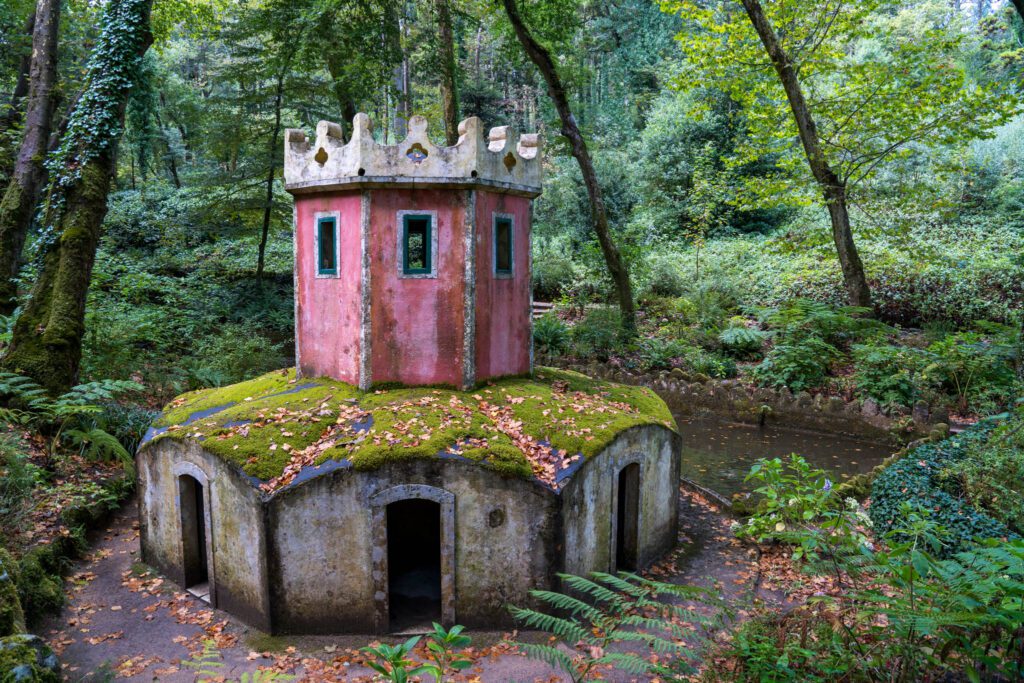
From there, head down through the gardens to the lower entrance, and walk up to the Moorish Castle.
Important Info: Tickets for the gardens cost 7.50 Euros, while combo tickets that include the interior cost 14 Euros. The castle is often shrouded in fog in the morning, which usually burns off by about 10:00 or 11:00 am. For that reason, we recommend above that you spend your time admiring the gardens first before heading up to the palace itself. More info here.
Castelo dos Mouros
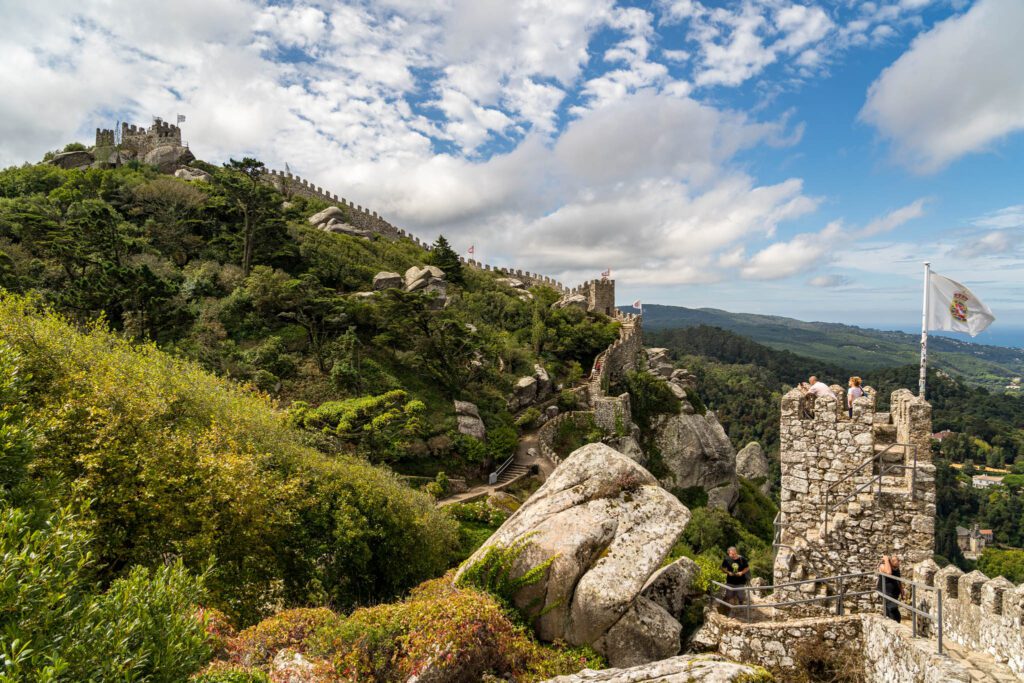
Honestly, we were SO close to skipping this. But we were so glad we didn’t! Walking along the reconstructed walls of this Moorish Castle from the 8th or 9th Century was the highlight of our time in Sintra, and the views are nothing short of spectacular.
It was built when the Muslims from North Africa were in control of the Iberian Peninsula, and then it was taken by the Christians in the 12th Century, and basically left in various levels of desertion ever since as tensions calmed and people no longer felt the need to live within the castle walls and started making their way downhill towards Sintra and proverbial greener pastures.
At least until the 1800’s, when restoration efforts began under King Ferdinand in the same vein as the Pena Palace restoration.
There are some historical sights to see along the way, but we’d focus your time on walking the walls from one end to the other, which involves some steps (which are actually kind of hard), and is basically a nonstop spectacular view from start to finish. Go counter-clockwise.


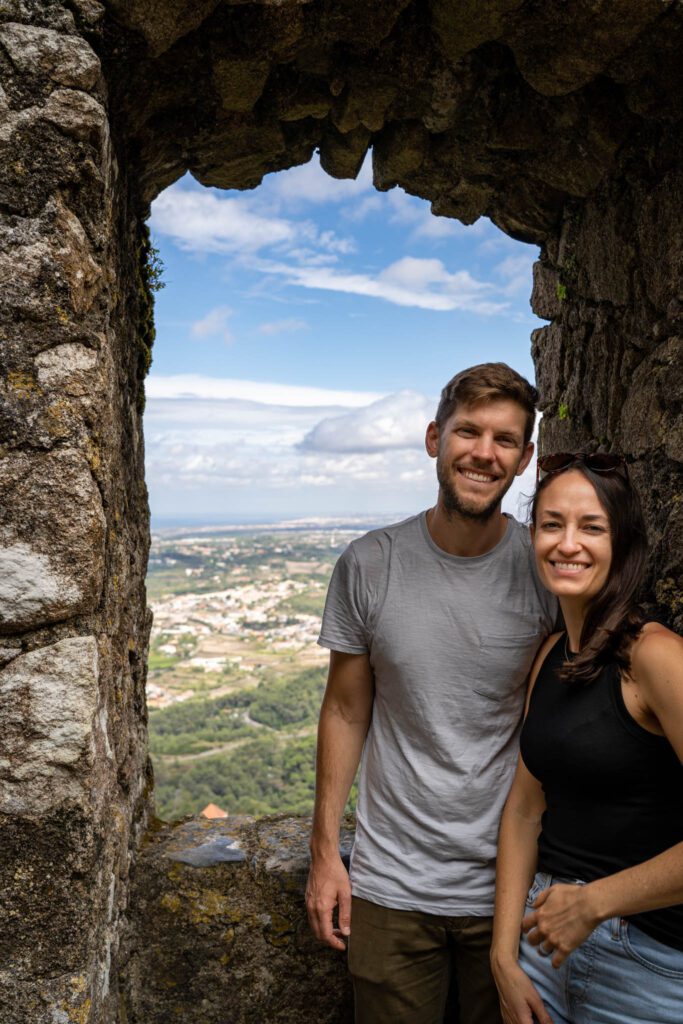
Important Info: The cost to enter the castle perimeter is 8 Euros. We originally balked at that cost, but afterwards decided it’s probably worth it for the great views alone. Plus, how often do you get to walk on former castle walls? More information here.
Less Time in Lisbon? Here’s What to Do
At a high level, if you have less than three days in Lisbon, we’d immediately cut Sintra. It’s great, don’t get us wrong, but we’d opt for spending your time in Lisbon itself rather than getting out of the city. Save it for next time.
With One Day in Lisbon
If you only have one day in Lisbon – and we mean one full day, morning, afternoon, evening, we’d spend it like this.
In the morning, head out to Belém and do the Torre de Belém, the Monument to the Discoveries, and the Jerónimos Monastery (though the cloister won’t be open when you’re there, which is fine) before going to Pastéis de Belém to try the alleged original pastel de nata.
Head back to Lisbon’s center and choose between the walking tour (if you’re more interested in history and culture) or the food tour (if you’re a foodie). Our preference is the walking tour, but you can’t really go wrong either way.
In the evening, follow the Alfama guide in the itinerary above and spend a few hours in the most romantic part of Lisbon, at least in our opinions.
PS: We have an entire guide dedicated to helping you make the most of one day in Lisbon.
With 2 Days in Lisbon
Follow days one and two of the itinerary above as written. Voila! 2 great days in Lisbon.
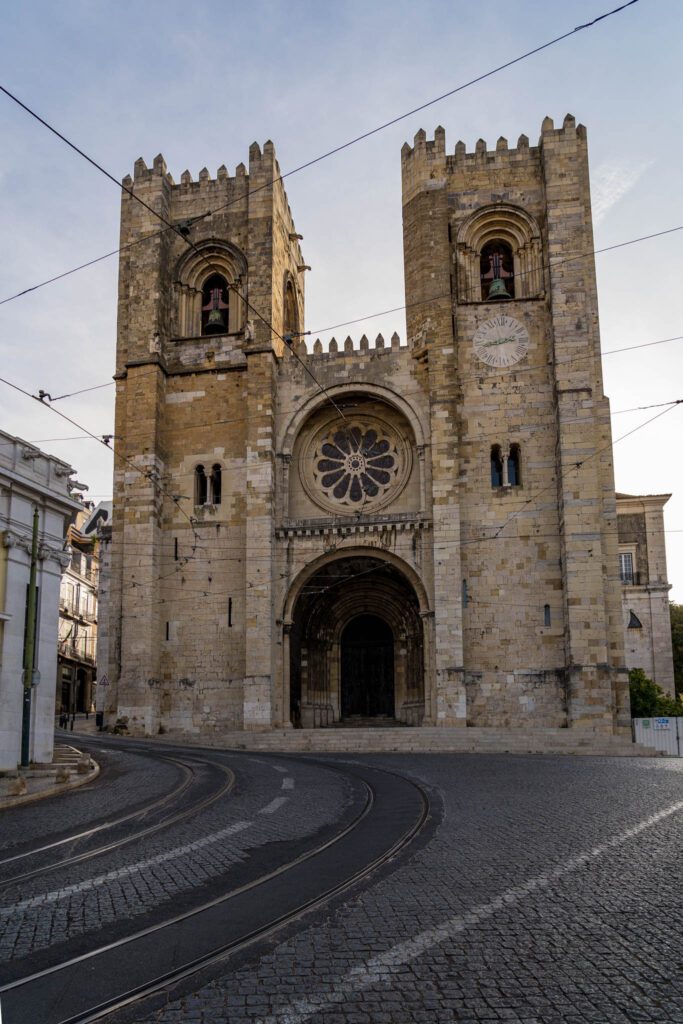
More Than 3 Days in Lisbon?
If you have more than three days, we’d recommend slowing down and splitting up the activities in the itinerary above, giving each more room to breathe.
In addition, here are a few things we’d add on to the itinerary.
- We’re really excited about the We Hate Tourism Tours “Lisbon Walk in the Real City.” The tour company here – We Hate Tourism Tours – focuses on responsible and sustainable tours. For example, you won’t find them packing groups of 20 people onto the 28 Tram, which is a major thoroughfare for locals, and it’s basically unusable at this point due to tourists between 10:00 am and 6:00 pm. Instead, you’ll spend a few hours exploring neighborhoods you probably wouldn’t make it to on your own, and learning about the cultural and economic context around the city you’re exploring. We haven’t done it (yet), but we will when we’re back in Lisbon in a couple of months. It’s a different kind of tour than the other walking tour you’ll have already done, focusing on parts of the city most tourists don’t make it to.
- The Time Out Market, as touristy as it is, is worth a visit. There’s a collection of some of the best restaurants in Lisbon all in one nice food hall, with a bar in the middle of it. Try a couple of different places and share amongst the group for the best experience. I’m still trying to wrap my head around why Time Out (of the magazine fame) got into the real estate / restaurant game, but that’s a question that’s out of scope for this particular guide.
- We kind of wanted to take a trip across the river over to Cacilhas after seeing Phil do it on our favorite food TV show of all time, Somebody Feed Phil. It involves a ferry ride, which also seems very pleasant. Here’s a nice guide to exploring that side of the river.
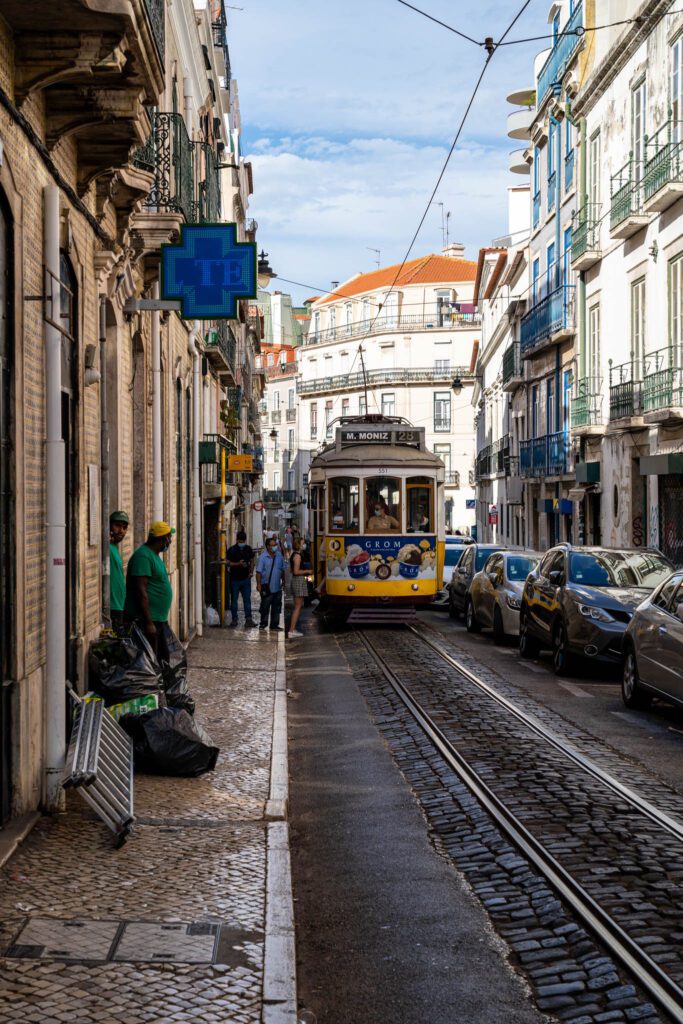
The Best Time to Visit Lisbon
Lisbon’s Mediterranean climate makes it a very pleasant destination basically year round, and a nice escape from the parts of Europe that have cold and dreary winters. Summer is blazing hot, and we’d say that visiting Lisbon in the summer is not ideal for two reasons.
First is the heat, which feels even warmer when you’re trekking straight up a hill. Second is the crowds, which are pretty overwhelming during July and August, which is peak summer season in Lisbon. It’s even worse when cruise ships are docked at the port near Alfama.
Shoulder season is our pick, which means Spring and Fall. We visited in September, and the weather was pleasantly warm (bordering on hot), and crowds were around, but nowhere near what you’d see at the height of summer.
We’re returning to Lisbon in December, so I will go ahead and update this guide with our thoughts on Lisbon in the winter after that trip.
Getting to Lisbon
Lisbon is fairly accessible from most parts of Europe thanks to plenty of flights coming into Portugal’s capital, though if you’re coming from outside of Portugal the train and bus situation leaves a bit to be desired. Flying is your best bet if you’re coming from continental Europe, the UK, or the US and Canada (obviously).
Flying to Lisbon
Lisbon’s airport is right smack dab in the middle of the city, which makes it easy to get from the airport to your accommodations.
Flights are plentiful, with most major carriers in Europe and abroad flying a route that takes you to Lisbon. You’ll arrive at Humberto Delgado Airport (LIS), which is 7km away from the city center.
Taking a Train or Bus to Lisbon
Trains or buses are a good way to get to Lisbon if you’re coming from a city within Portugal, like Porto to the north, or Lagos down on the Algarve, Portugal’s southern coast.
One note: if you’re staying in the main center of Lisbon, Santa Apolónia Station is the one you want. It’s walkable to Baixa and Alfama, and you can hop on the metro to access other parts of the city from the train station. Oriente, Lisbon’s other train station, is further north and requires a longer journey to reach the heart of the city.
From Porto
From Porto, which is Portugal’s second biggest city (and is well worth a visit), it’s a three and a half hour train ride from Campanha Station in Porto to Lisbon’s Santa Apolónia station.
Express Trains – called Alfa Pendular or AP – take two hours and forty five minutes or so, and are the most expensive (and comfortable) option.
Intercity trains – called Intercidades or IC – are cheaper, less comfortable, and take a little longer at three and a half hours.
For what it’s worth, we took multiple IC trains, and it was plenty comfortable and super affordable, especially when you buy tickets in advance.
From Lagos or Faro on the Algarve
You have a choice between train and bus, which are essentially the same journey in terms of time and cost.
The train leaves from Lagos and makes a connection in Tunes. From there, it’s a straight shot up to Lisbon. The bus runs directly from Lagos’ bus station to Lisbon – no connection required. Both options will cost you roughly 20 Euros.
The only major city outside of Portugal that has reliable service to Lisbon is Seville, Spain, but you’ll need to budget an entire day to make the trip.
From Seville, you can take a FlixBus that goes directly from Seville to Lisbon, taking roughly eight hours to complete the journey. Your other option from Seville is to take the bus to Faro, and catch the train up to Lisbon from there, which takes more like 8-10 hours.
Getting Around Lisbon
Lisbon is a great walking city, despite the hills. It reminds me a lot of San Francisco, our last home, in that way.
Most of the main sites and neighborhoods that you’ll want to visit as a tourist are within walking distance of the center, with the exception of Belém and Alcântara (home to LX Factory), which are a short tram ride away.
On Foot

Lisbon – like most cities, really – is best explored on foot. You’ll discover all sorts of fun spots along the way if you use your own two feet to navigate the grid layout of Baixa, and the winding serpentine alleys of Alfama, Chiado, and beyond.
The obvious thing to note here is the hills. Lisbon is very hilly outside of Baixa and the area along the river. Chances are, you’ll be walking up and down the hills of Lisbon at some point, so be prepared with comfortable walking shoes and a reusable water bottle.
If walking the hills is a problem for you, you can use the metro or trams to get to the top of the hill, then meander your way back down.
Public Transportation
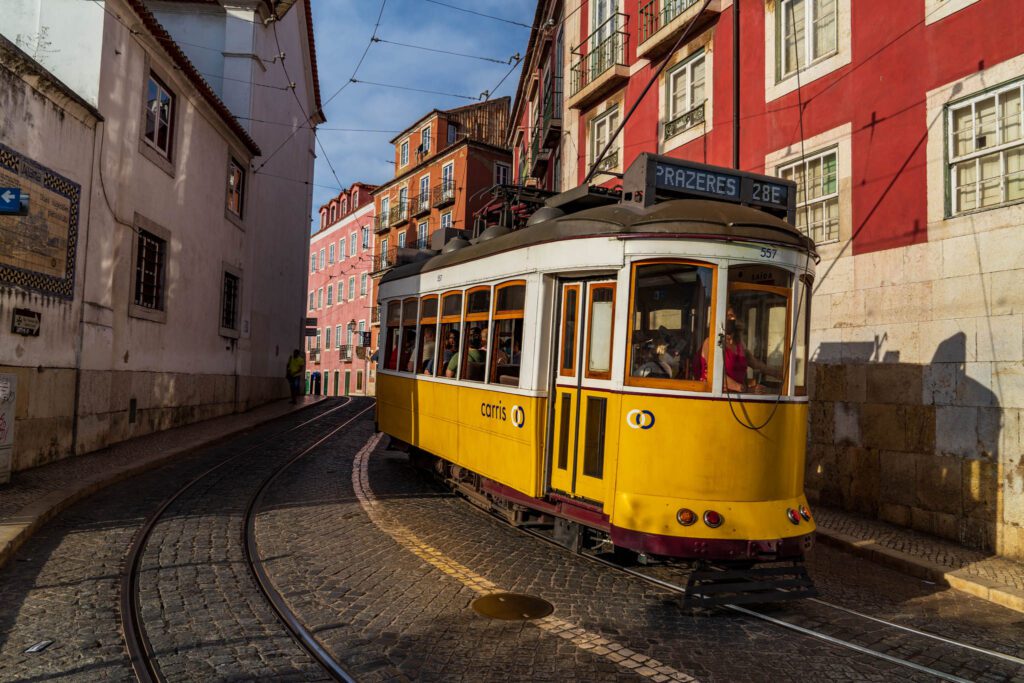
The public transportation in Lisbon is pretty fantastic.
There are above-ground trams, a below ground metro system, a few funiculars to get you up the crazy hills, and a bus system. It’s comprehensive, and will get you everywhere you need to go quickly, efficiently, and for a really affordable per-trip rate, too.
We were also really, really surprised at how clean everything was. From sparkling trams (other than the 28, but the rusticness is part of the charm!) to pristine buses, everything seemed a lot cleaner than the public transportation we’re used to taking in San Francisco. Like, A LOT cleaner.
To use the public transportation system, you’ll want to buy a Viva card, which costs 0.50 Euro and makes each ride significantly cheaper, and then you’ll be able to load it (and reload it) with the amount of money you need to ride.
You can get the Viva Card at one of the machines inside a metro station – they have instructions in English if you don’t speak Portuguese. Here are the rates as of 2023 (you can check the most up-to-date figures here):
- Single ride: 1.50 Euros (1.34 if you’re using a Viva Card)
- Day Pass: 6.40 Euros
Make sure you validate your ticket at the little yellow stands near the entrance to metro stations before every ride, and whenever you make a transfer. Otherwise you could be in for a fine.
We’d recommend skipping the Santa Justa Lift (Elevador de Santa Justa), which is essentially a tourist trap. You can walk through the mall or up the hill from Baixa without paying the 5 Euros or waiting in the long line. It is, however, worth walking out to the top of the lift for the view out over Lisbon towards the Castelo.
Here’s a good guide to Lisbon’s public transportation system for some further reading.
Uber and Taxis
Uber is surprisingly affordable in Lisbon, and so are taxis. We’re fans of ridesharing apps in terms of convenience and ease of use (not so much in terms of the company itself, though), and you can pretty easily zip around Lisbon for about 5-7 Euros per ride. Only use marked taxis, and make sure they run the meter.
Taking a Taxi from the Airport
We hopped in a taxi at the airport, and got scammed like typical tourists immediately on arrival. I’m telling this story in hopes that you learn from my mistake.
The taxi pulled up alongside the official taxi line, which we had waited in, and the first red flag was that he pulled up at the curb, rather than one of the designated taxi pull-through spots (which, by the way, are genius – never seen pull-through taxi spots before!). I should have pulled the plug there.
Not knowing whether it was a flat rate ride or a metered situation was my second mistake. Taxis from the airport should be metered, and it should cost between 10 and 15 Euros to go to the city center. This guy told me it was a flat rate, and showed me a semi-official looking laminated piece of paper showing the rates.
Our ride came out to 27 Euros, and only after the fact did I realize that we got scammed.
The point is this: only use official taxis that pull into the designated spots at the taxi stand at Lisbon’s airport, and make sure they run the meter. Don’t pay more than 10-15 Euros for a ride, and ask roughly how much it will cost before you get in. Decline anyone that tells you it’s a flat rate.
Actually, the real point is TAKE THE METRO from the airport. It’s super cheap, super efficient, and has a direct line to the city center. Here’s more on taking the metro to and from the airport.
We hope this massive guide to exploring Lisbon was helpful! If you liked this guide, there’s more where that came from.
Planning a trip to Portugal?
Here are our other Portugal travel guides to help you plan an incredible trip (even if you have to eat gluten free!).
If there’s no link below, it means we’re still working on it – long, in-depth guides take time! We’re working on it, though, we promise.
Portugal:
Lisbon
- 25 Incredible Things to Do in Lisbon: A Complete Guide
- 3 Days in Lisbon: Planning the Perfect Lisbon Itinerary
- One Day in Lisbon: The Best of Lisbon in 24 Hours
- Where to Stay in Lisbon: Our Guide to 4 Amazing Places to Stay
- Gluten Free Lisbon: A Complete Guide to Lisbon’s Best Gluten Free Restaurants
- The Best Coffee in Lisbon: 9 Amazing Lisbon Coffee Shops to Add to Your List
Porto:
- 3 Days in Porto: Planning the Perfect Porto Itinerary
- One Day in Porto: How to See the Best of Porto in a Day
- Where to Stay in Porto, Portugal: The 3 Best Places to Stay
The Algarve:

I am so happy that I found your blog posts on Portugal. We had 3 days in Lisbon and 3 days in Lagos. Your recommendation of the Be Poet Baixa Hotel made for easy walking to many of your suggestions. They also offered lots of information about sites and restaurants in the area. We enjoyed our time in Portugal and will be back again.
Hey Wendy! Glad you found it helpful and enjoyed your trip. Baixa is great in terms of location – you’re within a short walk or bus ride of just about everything! We like Chiado a tiny bit better in terms of vibe, but both are excellent choices. Noted on Be Poet Baixa – thanks for the info.